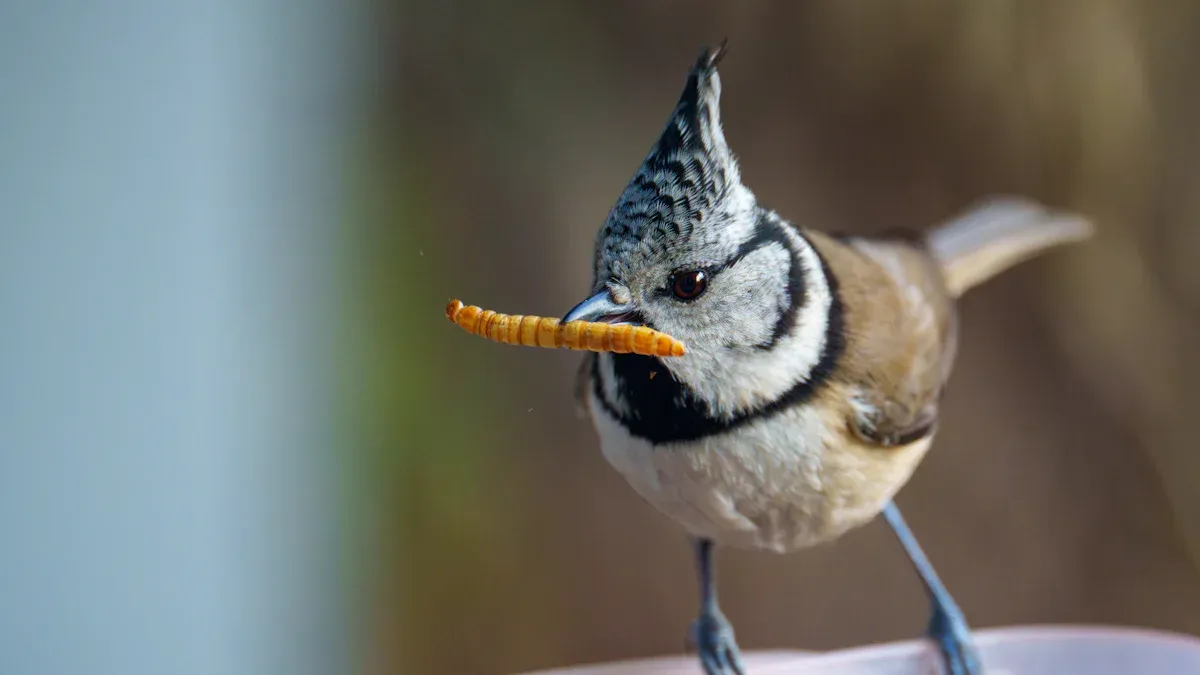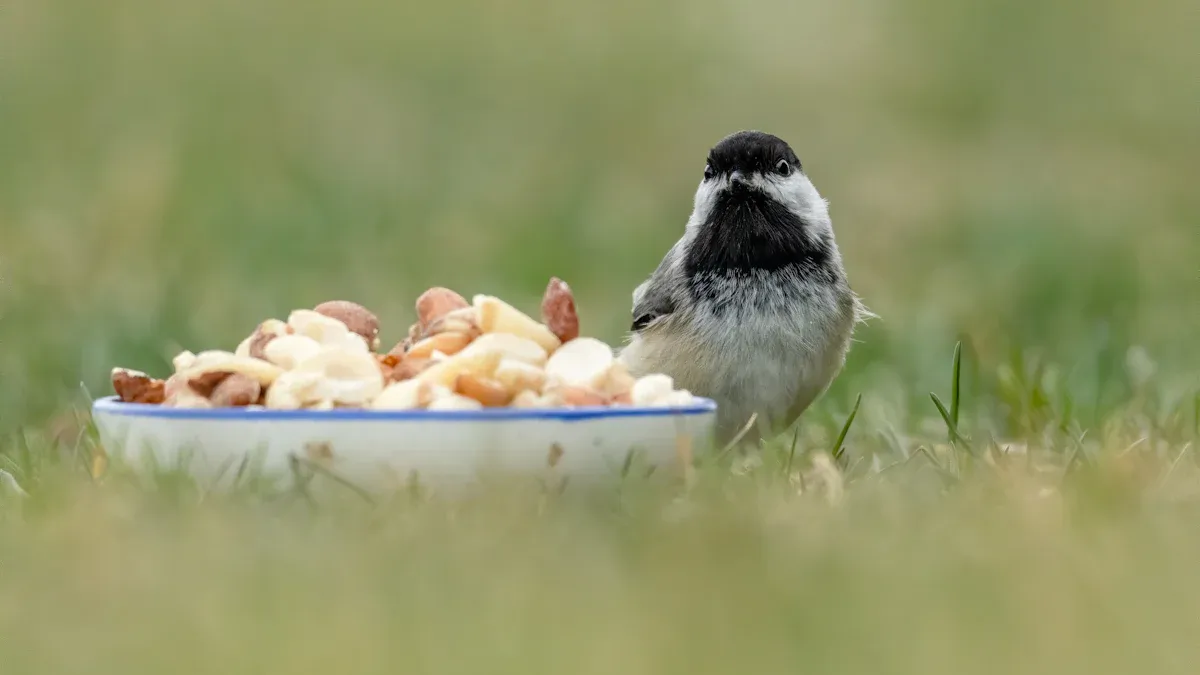
Mealworms are a fantastic treat for birds. These insects are a rich source of protein, fiber, and fats that are key for muscle development in birds. Live mealworms, in particular, are juicy and irresistible to species like finches, siskins, blackbirds, and robins. They’re especially helpful during breeding seasons when birds need extra energy to care for their young. Plus, offering mealworms for bird feeding can attract a variety of species to your yard, making birdwatching even more enjoyable.
Key Takeaways
- Mealworms are healthy snacks for birds. They give protein, fats, and vitamins to keep birds strong and active.
- Feeding live mealworms can bring many bird types to your yard. This makes birdwatching more fun.
- Keep mealworms fresh by storing them right. Use sealed containers for dried ones and keep live ones cool.
Nutritional Value of Mealworms for Bird
Protein and Energy Content
Mealworms are a powerhouse of nutrition for birds. They contain about 50% protein, which is much higher than many other bird food options. This makes them an excellent choice, especially during the breeding season when birds need extra energy to care for their young. Protein is essential for muscle development, feather growth, and overall vitality.
Here’s a quick comparison to show just how protein-packed mealworms are:
| Food Type | Protein Content |
|---|---|
| Mealworms | 50% |
Live mealworms, in particular, are juicy and irresistible to birds like finches, siskins, blackbirds, and robins. They also provide about 13% fat, which gives birds the energy they need to stay active and healthy. Whether you’re feeding them during the colder months or the breeding season, mealworms are a fantastic way to support their energy needs.
Essential Nutrients for Bird Health
Mealworms for bird feeding don’t just stop at protein and fat. They’re also packed with essential nutrients that contribute to a bird’s overall health. Here’s what they offer:
- Healthy fats: These include linoleic and linolenic acids, which are vital for energy and maintaining shiny feathers.
- Vitamins: Small amounts of vitamins A, B, and E help boost immunity and support growth.
- Minerals: Mealworms contain calcium, which is crucial for strong bones and eggshell production.
Dried mealworms are also rich in fiber, vitamins, and minerals, making them a convenient and nutritious option. Whether you choose live or dried, mealworms are a well-rounded food source that helps birds thrive.
Types of Mealworms: Live vs. Dried
Benefits of Live Mealworms
Live mealworms are a favorite among birds. They’re juicy, wiggly, and irresistible to species like robins, blackbirds, and finches. Offering live mealworms can make your yard a hotspot for bird activity. Here’s why they’re so effective:
- Live mealworms attract birds more effectively, especially when natural food sources are abundant.
- They help birds recognize your yard as a feeding spot, encouraging them to return even when you switch to dried mealworms later.
If you’re looking to attract a variety of birds or want to see them up close, live mealworms are a great choice. They’re especially helpful during breeding seasons when birds need extra energy to care for their young.
Benefits of Dried Mealworms
Dried mealworms are a convenient option for feeding birds. They’re easy to handle and store, making them perfect for busy bird enthusiasts. Here’s what makes them a great alternative:
- No special care is needed, and they have a long shelf life.
- You can store them easily and feed them to birds indoors or outdoors.
- They’re less messy than live mealworms, which makes them more practical for everyday use.
Many birds enjoy dried mealworms just as much as live ones. They’re a simple way to provide nutrition without the hassle of maintaining live insects.
Proper Storage Tips for Mealworms
Storing mealworms properly ensures they stay fresh and nutritious for your feathered friends. Follow these tips to keep them in top condition:
- For short-term storage, place dried mealworms in an airtight container in the refrigerator for up to two weeks.
- For long-term storage, freeze them in a sealed plastic bag to maintain quality for several months.
If you’re storing live mealworms, keep them at 40-50°F (4-10°C) to slow their metabolism. Use a plastic container with ventilation holes and bedding like wheat bran or oatmeal. Rotate your stock to minimize waste and ensure freshness.
By following these steps, you’ll always have high-quality mealworms for bird feeding, whether live or dried.
Birds That Are Attracted to Mealworms for Bird
Common Bird Species
Mealworms are a magnet for many bird species, especially those that love insects. If you’re wondering which birds might visit your feeder, here’s a list of common ones to look out for:
- Bluebirds
- Chickadees
- Robins
- Wrens
- Orioles
- Nuthatches
- Warblers
- Woodpeckers
Bug-eating birds, like bluebirds, are particularly fond of mealworms. They see them as a nutritious and easy-to-eat snack. You might also spot cardinals, sparrows, and grosbeaks stopping by for a treat. Offering mealworms can turn your backyard into a lively birdwatching spot, filled with chirps and fluttering wings.
Seasonal Feeding Considerations
The time of year plays a big role in how birds respond to mealworms. During winter, natural food sources like insects and berries become scarce. Mealworms provide a much-needed energy boost for birds trying to survive the cold. You’ll likely see more species visiting your feeder during this season.
In spring, mealworms become even more valuable. Birds need extra nutrients for nesting and raising their young. By offering mealworms, you’re helping them stay strong and healthy during this demanding time. Keep an eye out for parents bringing their fledglings to your feeder—it’s a heartwarming sight!
Whether it’s winter or spring, mealworms are a reliable way to support your feathered visitors. They’ll appreciate the effort, and you’ll enjoy the variety of birds they attract.
Practical Tips for Feeding Mealworms to Birds

How to Present Mealworms
How you present mealworms can make a big difference in attracting birds to your yard. Here are some effective ways to display them:
- Use a shallow dish or tray feeder to keep mealworms visible and accessible.
- Offer live mealworms briefly to grab birds’ attention, especially if they’re new to your yard.
- Soak dried mealworms in lukewarm water for a few minutes to make them plumper and more appealing.
Live mealworms are naturally more enticing because they wiggle and catch birds’ eyes. However, they require more care. Dried mealworms are easier to handle and store, making them a practical choice for everyday feeding. By experimenting with these methods, you’ll find what works best for your feathered visitors.
Encouraging Birds to Eat Mealworms
If birds in your area aren’t familiar with mealworms, don’t worry. You can encourage them to give this nutritious treat a try:
- Start with live mealworms to attract their attention. Birds are more likely to notice and eat moving food.
- Gradually switch to dried mealworms once they recognize your feeder as a reliable food source.
- Soak dried mealworms in water to enhance their texture and make them more appetizing.
Patience is key. Once birds discover how tasty mealworms are, they’ll keep coming back for more.
Feeding Frequency and Portion Sizes
Mealworms are best offered as a treat rather than a primary food source. Here’s how to manage feeding frequency and portions:
- Offer small amounts of mealworms a few times a week.
- During spring, increase feeding frequency to support birds laying eggs or feeding their young.
- Expect local birds to eat around 100 mealworms per day once they find your feeder.
By feeding mealworms in moderation, you’ll provide birds with a protein-packed snack without overfeeding them. This balance helps maintain their health and keeps them visiting your yard regularly.
Feeding birds with mealworms offers so many benefits. These insects are a rich source of protein, fiber, and fats that are key for muscle development in birds. Live mealworms, in particular, are juicy and birds find them extremely tasty, especially finches, siskins, blackbirds, and robins. Mealworms for Bird feeding are especially helpful during winter and spring when natural food is scarce.
“The connection that is created between people and nature from feeding birds—that is indisputable,” said Emma Greig, the project leader of Project FeederWatch.
By adding mealworms to your bird-feeding routine, you’ll attract a variety of species to your yard. Watching these feathered visitors can bring joy and even improve your well-being. So, why not start today? Your backyard could become a lively haven for birds and a peaceful retreat for you.
FAQ
What makes mealworms such a great food for birds?
Mealworms are packed with protein, fiber, and fats. These nutrients help birds build muscles, grow feathers, and stay active. Live mealworms are especially juicy and irresistible to many species.
How do I keep live mealworms fresh?
Store live mealworms in a ventilated container with bedding like wheat bran. Keep them cool at 40-50°F to slow their metabolism and maintain freshness.
Can I feed mealworms to birds year-round?
Yes! Mealworms are perfect for winter when food is scarce and spring when birds need extra energy for nesting. They’re a reliable treat for all seasons.


